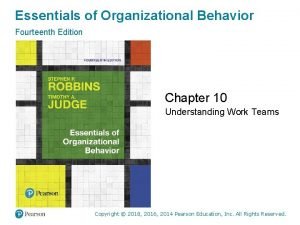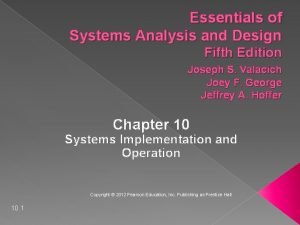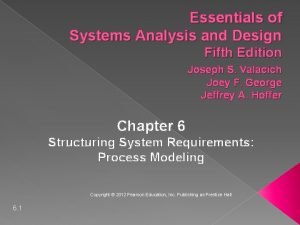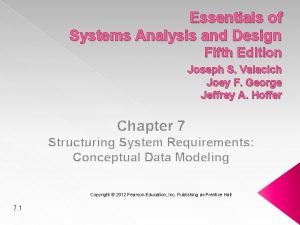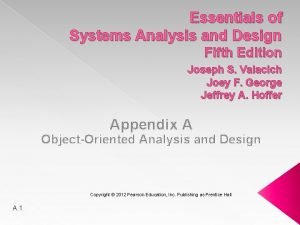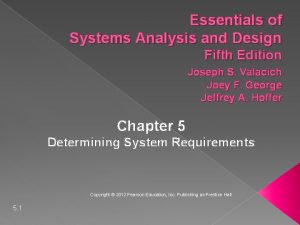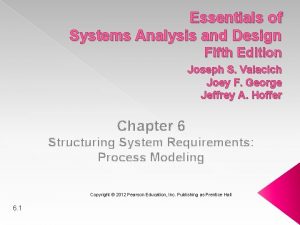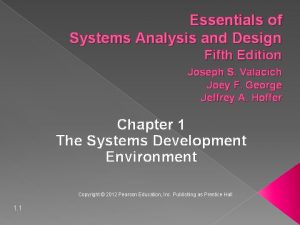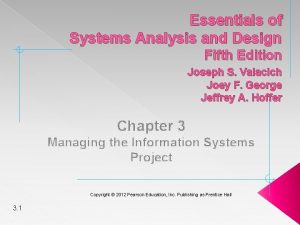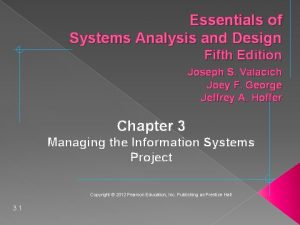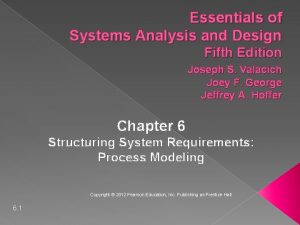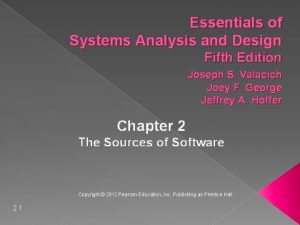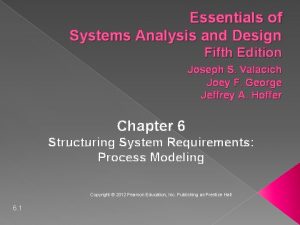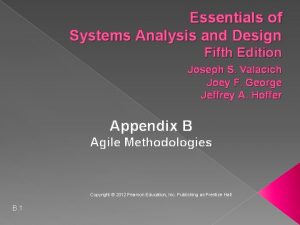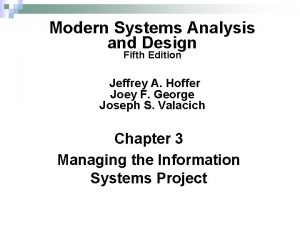Essentials of Systems Analysis and Design Fifth Edition























- Slides: 23

Essentials of Systems Analysis and Design Fifth Edition Joseph S. Valacich Joey F. George Jeffrey A. Hoffer Chapter 1 The Systems Development Environment 1. 1 Copyright © 2012 Pearson Education, Inc. Publishing as Prentice Hall

Learning Objectives ü Define information systems analysis and design ü Discuss the modern approach to SAD that combines process and data views ü Describe the role of the systems analyst ü Describe the SDLC and alternatives ü Describe role of computer aided software engineering (CASE) tools 1. 2 Copyright © 2012 Pearson Education, Inc. Publishing as Prentice Hall

What is Information Systems Analysis and Design? • A method used to create and maintain systems that perform basic business functions • Main goal - to improve employee efficiency by applying software solutions to key business tasks • A structured approach to ensure success • Systems Analysts perform SAD based upon: – Understanding of organization’s objectives, structure and processes – Knowledge of how to exploit information technology for advantage 1. 6 Copyright © 2012 Pearson Education, Inc. Publishing as Prentice Hall

1. 4 Copyright © 2012 Pearson Education, Inc. Publishing as Prentice Hall

Systems Analysis and Design: Core Concepts • Major goal: to improve organizational systems by developing or acquiring application software and training employees in its use • System: Turns data into information and includes: – – – 1. 5 Hardware and system software Documentation and training materials Job roles associated with the system Controls to prevent theft or fraud The people who use the software to perform their jobs Copyright © 2012 Pearson Education, Inc. Publishing as Prentice Hall

Systems Analysis and Design: Core Concepts 1. 6 Copyright © 2012 Pearson Education, Inc. Publishing as Prentice Hall

Software Engineering Process 1. 7 Copyright © 2012 Pearson Education, Inc. Publishing as Prentice Hall

System • A system is an interrelated set of business procedures used within one business unit working together for a purpose • A system exists within an environment • A boundary separates a system from its environment • A system has nine characteristics 1. 8 Copyright © 2012 Pearson Education, Inc. Publishing as Prentice Hall

Characteristics of a System › › › › › Purpose Environment Boundary Components Interrelationships Constraints Interfaces Input Output 1. 9 Copyright © 2012 Pearson Education, Inc. Publishing as Prentice Hall

Important System Concepts • Decomposition – The process of breaking down a system into smaller components – Allows the systems analyst to: • Break a system into small, manageable and understandable subsystems • Focus on one area at a time, without interference from other areas • Concentrate on component pertinent to one group of users without confusing users with unnecessary details • Build different components at independent times and have the help of different analysts 1. 10 Copyright © 2012 Pearson Education, Inc. Publishing as Prentice Hall

Important System Concepts • Modularity – Process of dividing a system into modules of a relatively uniform size – Modules simplify system design • Coupling – Subsystems that are dependent upon each other are coupled – Desired: loose coupling • Cohesion – Extent to which a subsystem performs a single function – Desired: high cohesion 1. 11 Copyright © 2012 Pearson Education, Inc. Publishing as Prentice Hall

Cohesion and Coupling Effective modularization = max. cohesion within modules + min. coupling between modules 1 2 component 3 4 component High cohesion 5 Bridge Adapted from Software Engineering: An Object-Oriented Perspective by Eric J. Braude (Wiley 2001), with permission. 6 Low coupling

Cohesion and Coupling 1. 13 Copyright © 2012 Pearson Education, Inc. Publishing as Prentice Hall

A Modern Approach to Systems Analysis and Design • Systems Integration – Allows hardware and software from different vendors to work together – Enables procedural language systems to work with visual programming systems – Visual programming environment uses client/server model 1. 14 Copyright © 2012 Pearson Education, Inc. Publishing as Prentice Hall

SA role in Systems Development • Study problems and needs of an organization • Determine best approach to improving organization through use of: – People – Methods – Information technology • Help system users and managers define their requirements for new or enhanced information systems 1. 15 Copyright © 2012 Pearson Education, Inc. Publishing as Prentice Hall

Systems Development Methodology … e. g. SDLC 1. 16 Copyright © 2012 Pearson Education, Inc. Publishing as Prentice Hall

Phases of the Systems Development Life Cycle 1. Systems Planning and Selection – Two Main Activities • • Identification of need Investigation and determination of scope 2. Systems Analysis – Study of current procedures and information systems • • 1. 17 Determine requirements Generate alternative designs Compare alternatives Recommend best alternative Copyright © 2012 Pearson Education, Inc. Publishing as Prentice Hall

Phases of the Systems Development Life Cycle 3. System Design – – Logical Design - Business aspects of the system Physical Design - Technical specifications 4. System Implementation, Operation and Maintenance • • • 1. 18 Hardware and software installation User Training Documentation Operations Maintenance (fix errors, make changes) Copyright © 2012 Pearson Education, Inc. Publishing as Prentice Hall

Alternative Approaches to Development • Prototyping – Building a scaled-down working version of the system – Advantages: • Users are involved in design • Captures requirements in concrete form – Disadvantages: • Users may misunderstand SD complexity • Code often thrown away 1. 19 Copyright © 2012 Pearson Education, Inc. Publishing as Prentice Hall

Alternative Approaches to Development • Joint Application Design (JAD) – Users, Managers and Analysts work together for several days – System requirements are reviewed – Structured meetings • Rapid Application Development (RAD) – Utilizes prototyping to delay producing system design until after user requirements are clear 1. 20 Copyright © 2012 Pearson Education, Inc. Publishing as Prentice Hall

1. 21 Copyright © 2012 Pearson Education, Inc. Publishing as Prentice Hall

Approaches to Development • Agile Methodologies – Extreme Programming, Adaptive S/W Development, Scrum – Focuses on • Adaptive methodologies • People instead of roles • Self-adaptive development process 1. 22 Copyright © 2012 Pearson Education, Inc. Publishing as Prentice Hall

Computer-Aided Software Engineering (CASE) Tools • Automated software tools used by systems analysts to develop information systems • • 1. 23 Project management tools (Openproj, MS Project) Diagramming tools (Dia, Visio) Computer display and report generators (VB) Analysis tools (Visual Analyst) Documentation generators Code generators Integration of tools via a repository Copyright © 2012 Pearson Education, Inc. Publishing as Prentice Hall
 Essentials of systems analysis and design
Essentials of systems analysis and design A modern approach to systems analysis and design
A modern approach to systems analysis and design Modern systems analysis and design 7th edition
Modern systems analysis and design 7th edition Principles of marketing fifth european edition
Principles of marketing fifth european edition Appraisals in lazarus's theory of emotion
Appraisals in lazarus's theory of emotion Fundamentals of corporate finance fifth edition
Fundamentals of corporate finance fifth edition Fifth edition chemistry a molecular approach
Fifth edition chemistry a molecular approach Molecular biology of the cell
Molecular biology of the cell Molecular biology of the cell fifth edition
Molecular biology of the cell fifth edition Human anatomy fifth edition
Human anatomy fifth edition Human anatomy fifth edition
Human anatomy fifth edition Network security essentials 5th edition pdf
Network security essentials 5th edition pdf Business essentials 12th edition chapter 1
Business essentials 12th edition chapter 1 Essentials of investments 11th edition
Essentials of investments 11th edition Understanding business 12th edition chapter 1
Understanding business 12th edition chapter 1 Essentials of sociology 5th edition
Essentials of sociology 5th edition Firefighter essentials 7th edition
Firefighter essentials 7th edition Business essentials 12th edition
Business essentials 12th edition Management information systems 13th edition
Management information systems 13th edition Essentials of organizational behavior 14th edition
Essentials of organizational behavior 14th edition Essentials of firefighting 7th edition
Essentials of firefighting 7th edition Network security essentials 5th edition
Network security essentials 5th edition Criminal justice the essentials 5th edition
Criminal justice the essentials 5th edition Systems analysis and design kendall and kendall
Systems analysis and design kendall and kendall



















